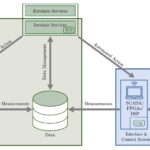 TDK Corporation has introduced two new types of the EPCOS InsuGate series (B78541A). These compact SMT transformers with high working voltage are suitable for gate driver applications for IGBTs and MOSFETs in e-mobility and industrial electronics. The components with a MnZn ferrite core are designed for operating frequencies of 100 kHz to 500 kHz and operating temperatures of -40 °C to +150 °C. Depending on the type, the transformation ratios of the windings are 1:1.08 (B78541A2467A003) or 1:1.07:0.6 (B78541A2492A003). With a low coupling capacitance of only 4 pF, the SMT transformers are also suitable for use with SiC or GaN semiconductors.
TDK Corporation has introduced two new types of the EPCOS InsuGate series (B78541A). These compact SMT transformers with high working voltage are suitable for gate driver applications for IGBTs and MOSFETs in e-mobility and industrial electronics. The components with a MnZn ferrite core are designed for operating frequencies of 100 kHz to 500 kHz and operating temperatures of -40 °C to +150 °C. Depending on the type, the transformation ratios of the windings are 1:1.08 (B78541A2467A003) or 1:1.07:0.6 (B78541A2492A003). With a low coupling capacitance of only 4 pF, the SMT transformers are also suitable for use with SiC or GaN semiconductors.The combination of the highly resistive plastic material with a CTI ≥ 600 and the special coil design allows for shorter clearances and creepage distances compared to conventional insulated or potted components, despite the dimensions of only 13.85 x 10.5 x 9.2 mm (L x W x H). The UI7 platform, for example, offers creepage distances between primary and secondary windings of >9.2 mm. With a partial discharge extinction voltage of at least 840 V (peak voltage) and AC high voltage testing at 3 kV (50 Hz, 1 s), the lightweight components meet IEC 61558 for reinforced insulation for working voltages up to 300 V (AC) or 700 V (DC) for basic insulation.
The new UI7 family includes two reference models to allow possible winding configurations for forward and push-pull topologies with the appropriate number of outputs.
The main applications for these new transformers include switched power supplies (bridge topologies), gate driver circuits, isolated DC-DC converters, and galvanically isolated single-channel IGBT driver ICs. The transformers offer a range of features and benefits, such as compact dimensions of 13.85 x 10.5 x 9.2 mm (L x W x H), making them surface mountable (SMT). They also have clearance and creepage distances of 8.14 mm and 9.2 mm respectively, as well as a low coupling capacitance of 4 pF (typical). Additionally, the transformers are qualified according to AEC-Q200 and AQG vibration profile standards.







Leave a Reply